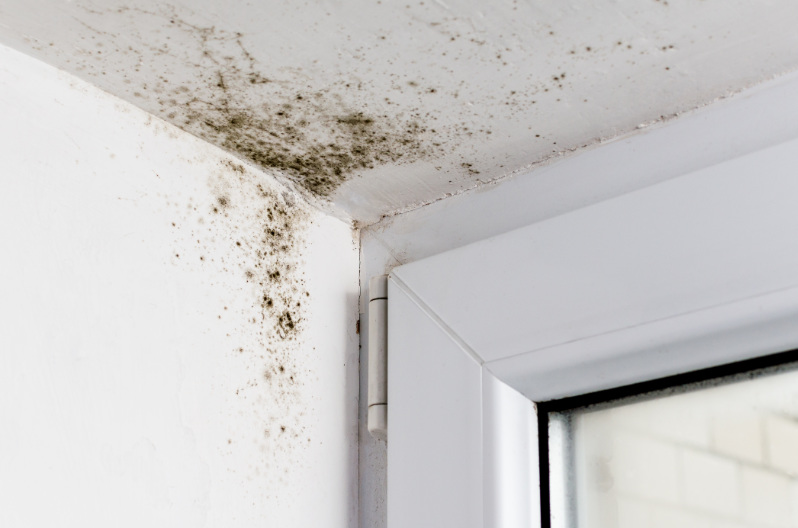There are many misconceptions about mold, but the biggest two are what causes mold and how to prevent it in your house. Most people think of it as the problem, but mold is the symptom of a water problem. Since water causes mold, it will come back until you get rid of the water source. We explain the causes and how to prevent mold in your home.
What Causes Mold in a House?
Any source of water can cause mold in your house. While you probably clean up a flood or large pool of water, it’s easy to ignore slow leaks, condensation, and a little spill on the countertop. However, they are just as likely to cause mold as a flood or sewage backup.
Here are the common causes of mold:
- Condensation, commonly in the bathroom and kitchen and on windows
- Humidity, especially if there is a big difference between the temperature outside and inside
- Plumbing leaks, floods, or overflows
- Not cleaning up water spills, even minor ones in the kitchen or bathroom
- Wet towels, washcloths, sponges, and floor mats
- Storing wet materials, especially paper, cardboard, and fabric
- Leaky or overflowing appliances like dishwashers or washing machines
- Groundwater flooding
- Roof leaks from damaged shingles and flashing or ice dams
- Cracked or leaking foundation walls and floor
- Clogged gutters and downspouts
- Clogged or cracked exterior drain tiles
- Improper grading around your foundation
How Do You Get Mold?
You may think you get mold from dirty conditions, but it is a naturally occurring airborne fungus. Unfortunately, it can use most things in your home as food as long as they remain wet. Since mold spores exist in the air around us, they will grow on almost anything wet.
Mold can grow on wood, drywall, carpeting, paper, cardboard, paneling, ceiling tiles, insulation, fabric, upholstery, dust, lint, and even paint. While it can appear in as little as 24 to 48 hours, it usually takes a week or more to appear the first time. Once you have mold in your home, the chance of it spreading increases.
How To Prevent Mold in Your Home
From regular cleaning and inspection to improved ventilation, take steps to prevent mold growth in these locations.
- Find and Fix Water Problems: One of the best ways to prevent mold is to check for water problems. Look out for damp spots, condensation, or standing water and fix the problem immediately.
- Clean and Dry Wet Areas: If you have water or condensation, remove the water and dry the area immediately. The longer you wait, the greater the risk of mold. Sewage increases the chances of mold problems.
- Use Exhaust Fans for Condensation: Use exhaust fans in kitchens and bathrooms to vent excess humidity and prevent condensation. Always vent clothes dryers and furnaces outside.
- Monitor Humidity Levels: If you live in a humid climate, monitor humidity levels in your home to prevent mold. The EPA recommends a consistent humidity level between 30% and 60%. Mold can grow above 60% humidity with even trace amounts of water or moisture.
- Improve Ventilation and Airflow: Make sure there is good airflow in your home. Check vents in your basement and attic so excess moisture can escape. Open closet doors and run fans to circulate air.
- Run Dehumidifiers to Remove Humidity: Use dehumidifiers to remove humidity from the air. Avoid using humidifiers and appliances that generate moisture if you see condensation forming on your windows, walls, or ceiling.
Where Should You Look for Mold?
Here are the most common places to check for mold:
- Kitchen: Check under the sink and around the dishwasher for water leaks and excess moisture. Ensure the caulk work around the faucet and sink are in good condition. Prevent mold by installing an exhaust fan to remove excess moisture from cooking.
- Bathrooms: Look under the sink and around the toilet, bathtub, and shower for areas that collect moisture or condensation. Replace worn-out caulk and grout work in the tub or shower. Improve air movement by installing an exhaust fan if necessary.
- Basement: It is usually easy to spot moisture and mold in unfinished basements. Check along the foundation, around windows, and openings to the outside. Also, look at your heating and cooling systems, water heater, and plumbing fixtures. It can be more difficult to find in finished basements, so look for water stains, damp spots, or deteriorating drywall, carpeting or flooring, ceiling materials, and furniture.
- Laundry Room: Check the water supply and drainage lines for cracks and damage at least once a year. Replace worn-out hoses immediately to prevent leaks that will cause mold. If your washing machine drains to a washbasin or utility sink, use a lint catcher to keep the drain running smoothly. Also, check the exhaust ductwork on your dryer and remove lint clogs every few months.
- Attic: If you can see the underside of your roof, inspect it for water stains and ensure all wood is in good condition. Check the chimney for damaged or deteriorating masonry. If you cannot see the underside of the roof, check the exterior for damage and deterioration that will allow water into your home. Air movement helps prevent mold, so improve your attic ventilation if necessary.
Do you still have a mold problem? Our technicians have the training and equipment to remove the mold and prevent it from returning. Call 1-888-681-1071 now to speak with our on-call mold remediation contractor in your area. They always provide free quotes and can start work whenever you are ready.





